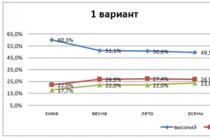When ordering various goods in online stores, you most likely saw the item "cash on delivery" in the list of delivery and payment options for the purchase. What it is?
Definition
Cash on delivery - this is one in which the buyer receives the goods at the post office only after he pays the employees of the department a certain amount.
What is included in the amount
Those who have already dealt with this know that the final amount of the declared value (that is, just the money that the buyer pays in the mail) is somewhat higher than the price of the goods indicated in the catalog of the online store itself.
This is due to the fact that the amount of cash on delivery, in addition to the actual cost of the goods, as a rule, also includes the costs associated with packing and shipping the order.
In addition, each buyer pays a certain percentage of the parcel in accordance with the tariffs of the mail itself - this money is needed so that the post office subsequently sends the funds paid by the buyer to the sender.
But, as they say, “the wolf is not as scary as it is painted”: in addition to the main amount at the post office, the buyer pays no more than 100-300 rubles (it all depends on the price of the product itself). Of course, the fact how expensive the purchase is in itself matters, because basically everything is calculated in percentages.
How to send goods cash on delivery?
This information will be useful for sellers who want to send an item using cash on delivery. You already know what it is - it means that it is easy to imagine how the sending procedure approximately takes place.

To begin with, the seller must indicate his intention to send the parcel to the postal workers. In the department, he receives an empty postal order form, as well as 2 forms for completing an inventory (as when sending a valuable parcel).
The seller fills in the postal order in his own name on behalf of the buyer. In addition to the estimated cost of delivery, the amount must also include 8% of the commission charged by the post office for the delivery of valuable parcels.
After the postal worker checks the documents, the postal order form is attached to the parcel post. The seller is issued a postal receipt and an inventory form certified by mail.
The buyer, in turn, can receive the purchase only after he pays for the goods - this is cash on delivery. Tariffs on both sides are quite low, but they must be taken into account so that the process of forwarding and delivery of the order goes smoothly.
Advantages and disadvantages of cash on delivery for buyers
The main advantage that cash on delivery has in this regard is a kind of guarantee for the buyer. After all, you pay not for some ephemeral product that may not be sent to you at all (many do not trust online stores for this very reason), but for a parcel that is already in the department. As soon as you pay the required amount, the shipment is transferred to you, that is, you receive your order. That is why cash on delivery is so popular that it is really beneficial for the buyer: you do not need to pay for the parcel immediately after placing the order - there is still a certain amount of time left until the goods arrive at the post office.
As for the shortcomings, first of all it is the need to overpay a certain amount, albeit a small one. In addition, it is impossible to inspect the contents of the parcel before payment. And if an unscrupulous seller sent you something completely different from what you ordered, you can only contact the police.
Advantages and disadvantages of cash on delivery for merchants
If you send cash on delivery items (or any other goods), you are guaranteed to receive payment for them.
Of the shortcomings, first of all, it should be noted the risk that the client simply does not pick up his order, and the goods will be sent back to you. And everything would be fine, but only sending by mail itself takes a lot of time (from 3-5 days to several weeks). As a result, there is a risk of delay in turnover and, as a result, the online store incurs losses.
However, despite occasional misunderstandings, many merchants are convinced that cash on delivery is one of the most popular payment methods. There is no doubt - thousands of online stores successfully send products in this way, and millions of buyers are happy to pick up their long-awaited purchases from the post office.

We have told you about the main risks, but you should understand that risks are just possible situations that rarely occur in practice.
Today, cash on delivery is considered the most expensive way to deliver goods or items. At the same time, cash on delivery, which includes the cost of the goods and the cost of sending money to the seller, is completely unjustified. After all, it does not protect either the rights of the buyer or the rights of the seller.
The selected and ordered goods on the site are packed and sent by mail. At the same time, the buyer is obliged to purchase this product at the post office through the payment of the designated cash on delivery. And at the same time, you can notice that the cost of sending by mail significantly exceeds the cost of it, but by prepayment through the bank.
Why is this happening? The thing is that for their services, the post office necessarily “throws on top” the cost of the insurance fee, which is imposed on the shipment when it is sent, plus a commission fee when it is received. It turns out that the buyer, due to his ignorance of these details, unconsciously overpays more than 10% of the commission cost directly to the mail, deluded that he will first be allowed to look at the product, and only then, if everything suits him, pay for it.
The seller, in turn, risks the money spent on long-distance shipping back and forth if the parcel is not redeemed at the post office by the customer.
The highest shipping price!
Yes, this is a confirmed fact. It is the “cash on delivery” that ends up being more expensive even if the client chooses air delivery by expedited first class and with 100% insurance.
What increases the cost of the ordered goods?
The thing is that, in fact, cash on delivery is a double operation. That is, along with the registration of the service for the issuance of the item at the post office, the service for the money transfer to the seller is also issued at the same time. Its cost usually ranges from 4 to 7 percent (according to standard postal rates) of the transferred amount. This percentage is necessarily added to the total cost of the goods sent.
Due to the ignorance of buyers at post offices, scandals and accusations against postal employees are not uncommon, ending in the customer's refusal to receive the parcel. At the same time, he, the buyer, feels cheated, the parcel is returned to the seller, who pays for her "journey" around the country and also feels "circled around her finger." Thus, the store suffers losses in the amount of the amount paid for the packaging and delivery of the parcel.
And it is worth noting moreover, since cash on delivery can only be subject to goods with a declared and fixed value, the cost of shipping increases.
Is cash on delivery more expensive than a prepaid package?
Of course, the answer to this question will be positive. After all, in addition to the cost of the parcel (ordered goods) at the post office, you will need to pay for insurance and send money to the seller, which is actually carried out using a postal order. And the post necessarily charges a certain percentage for its services.
So the result of receiving a parcel using the "cash on delivery" service is not always comforting, especially for the customer. As a rule, the amount of payment is 30 percent higher than even the postal delivery of an order with prepayment.
Complete lack of security guarantees!
Is it safe to receive goods using the cash on delivery service?
There are no guarantees for goods that are sent using cash on delivery. Therefore, you should be as careful as possible when ordering a product in the online store. Many of the Internet sellers are ordinary scammers who have their goal solely to deceive the buyer. If this is found, contact the police.
Many customers think that receiving a parcel via cash on delivery is a safer procedure than prepaid. But this is a big misconception. You still get the right to open the parcel only after transferring the money to the cashier in full, including the percentage for postal services and forwarding. At the same time, there is no insurance and guarantee that the item or product you order will not be replaced by another, cheaper and less quality one.
The only advantage of cash on delivery is the so-called temporary deferred payment, that is, you do not need to pay the cost of the order immediately, but it is possible to collect the required amount during the time that the parcel will go to your post office.
But, you can not, of course, blame all online stores for fraud. It is important to remember that your goods must pass through the hands of postal employees, and fraud and substitution of goods in the parcel are also possible here.
Are there any rules for the customer to refuse to receive a cash on delivery shipment?
There is no official rule against refusing to receive your package. Of course, you can refuse to receive it. But, it is important to remember the rights of the seller. According to the law, the seller has the right to apply to the arbitration court during the contractual period and demand full reimbursement from the buyer-customer of the costs of sending and receiving the parcel. In addition, the seller has the right to demand compensation for the penalty (moral damage) and the legal services provided to him.
Moreover, it is necessary to recall the existence of the so-called “base of unreliable clients”. Access to it is open to every online store, and any seller has the right to include his customer in it, who, for unknown reasons, refused to receive the goods sent for him by cash on delivery. This database is open and accessible to almost all Internet sellers, and if the customer's name is found in its lists, he will be denied the service of sending goods by cash on delivery.
There is another option for the so-called unreliable client to receive an order: if he pays in advance, the cost of the order will be increased by an amount covering the possible risk that the seller suffers when working with such a client.
In order to subsequently protect the rights of the buyer and prove the fact of redemption of his parcel, any non-cash payment will be recorded in the banking system, or when paying in cash, he will be issued a receipt by the cashier, the presentation of which is sufficient to satisfy the plaintiff in court.
Benefits of cash on delivery
There are several advantages to cash on delivery. These will include:
- peace of mind while waiting for the goods, because you did not have to pay for it already, and you know for sure that the money was not wasted;
- no need to go to the bank and pay for the order. It will be enough to go to the post office after receiving a notice of the arrival of the parcel there in your name.
Disadvantages of cash on delivery service
At the same time, there are several negative points in cash on delivery, which are directly related to a more expensive service:
- The seller is charged additional shipping costs when sending the parcel, and he, in turn, increases the cost of the goods;
- You will also have to pay the post office for the services it provides for receiving goods, sorting them and transferring money.
Cash on delivery ordering process
Everything is quite simple: the client places an order by phone or the Internet, the sales manager sends a request to confirm the order (usually to an e-mail box). After confirmation, the order is formed and sent by mail. Upon receipt of the parcel at the address post office, the client receives a notification of receipt of the goods. The customer goes to the post office, pays and receives his parcel.
How quickly and in what way can I receive a parcel with cash on delivery?
The method of delivery depends on the classification of the shipment: parcel or parcel (depending on the size and dimensions of the ordered goods) to the post office. Delivery time usually ranges from 5-15 days, depending on the distance from the warehouse to the customer's city.
What is the limitation of postage with cash on delivery?
Shipments with the "cash on delivery" service are limited to one country. In this case, they are carried out only within Ukraine. The cost of payment will be indicated in the postal rules of shipments. Parcels are not sent using cash on delivery for military units and divisions, and to institutions with the address "Field Mail".
Are there any exceptions for opening cash on delivery packages before payment is made?
No. You can open the parcel and view the goods only after handing over the money to the cashier and receiving a receipt for payment. But, the buyer has the right to check the integrity of the package before that and check the weight of the package with the specified seller when sending it. In the absence of signs of opening the package, the Ukrainian Post does not accept claims for the contents of the parcel or parcel.
Frequently asked questions about the service "cash on delivery"
Is it possible to receive and open the parcel before payment?- Answer: No.
Is it possible to see the sent goods before transferring money to the post office?- Answer: No.
Is it possible to check the goods for defects before paying for the shipment?- Answer: No.
Is it possible to refuse the goods after opening the parcel and get the amount of payment back?- Answer: No.
Delivery payment statistics in Ukraine:

The main disadvantages of the "cash on delivery" service
- Firstly, cash on delivery is considered the most risky and fraudulent way to receive goods by mail. Indeed, in places where advanced technologies are being introduced very slowly (in villages and villages), and residents are simply unaware of the existence of other types of goods shipments, the risk of getting caught by a scam is minimal for a postal worker. But he will not contact the person who receives the parcel via expedited class, because he understands that this customer is aware of his rights and is legally “savvy” in matters of delivery and forwarding of goods.
- Secondly, cash on delivery is considered the most difficult type of shipment. The sender has to fill out different forms several times, draw up several inventories at once, and after that he has to track his shipments and control their delivery.
In this case, a courier (postman) is involved, who carries notifications of receipt of the parcel to the post office. The buyer must go to the department himself and, standing in line, pay for the parcel in cash and only then receive it and open it to check the goods.
The seller will receive money only 15-30 days after the parcel has been sent. And if the buyer does not receive it, the return journey will take at least a month. All this will lead to an increase in the cost of goods. - And thirdly, cash on delivery is the most expensive of all other types of shipments. And besides, it is far from always possible for technical reasons (the computer broke down, the Internet disappeared, and so on) to pay and receive the parcel on the day the buyer came for it.
In the case of a full prepayment for the goods, the parcel will be issued at any time, since it will no longer be necessary to pay for it.
Today in Russia a huge number of goods are purchased by mail. The number of sales of domestic and foreign online stores is growing every year. It is convenient to purchase in online stores, including due to non-cash payment. Online stores offer various forms of non-cash payment for their products, and often “cash on delivery” appears as one of the options. But many do not know - what is it and what does this term mean?
In simple words, we can reveal the definition of "cash on delivery" as follows - this is the purchase of something in this way, when the buyer arrives at the post office, pays money (makes a payment) for the goods delivered to him by the postal service employee, and after the payment is made - receives the goods. The received money is redirected by the post office to the seller, having received an established commission for the service rendered.
At first glance, working with cash on delivery is a convenient way of delivery and payment for both the buyer and the seller. Let's try to understand together with lawyer Gennady Efremov the intricacies of this type of payment in more detail and study its advantages and disadvantages.
What does the cash on delivery consist of?
So, we bought a product in an online store for a certain price. For example, it will be a thing worth 5000 rubles. As a form of money transfer, we have chosen cash on delivery. When placing an order on the page of the online store, we can immediately see the cost of the postal service that this organization takes as a reward for such support of an online purchase and sale transaction. This payment for postal services is cash on delivery.What does this remuneration for the postal service consist of? This may be the cost of packaging the product and shipping it. In addition to these costs, this also includes a percentage of the value of the goods in accordance with the tariff of the postal service, for the service of sending paid money to the seller. That is, a kind of commission for a money transfer.
In view of the foregoing, when buying a thing worth 5,000 rubles cash on delivery, in the end, when we receive the thing, we already pay 5,300 rubles, compensating all the costs of the intermediary (postal service) to accompany our purchase. The cost of postal services directly depends on the declared value of the goods being sent, and the more expensive it is, the higher the price for sending it.
The procedure for sending goods by cash on delivery
So, let's say you are a seller of goods and you have a person who wants to buy it. The order of interaction will be as follows:- We come to the post office and fill out the transfer form and the form for the inventory of the contents of the parcel.
- We fill in the form of a postal transfer to our passport data.
- Packing the parcel. We pass the parcel, a valuable envelope (depending on the size of the goods being sent) to the postal employee, and, in return, we receive a receipt and a certified inventory form.
- We pay the cost of delivery according to the tariffs of the Russian Post.
- The parcel arrives at the post office of the buyer and is issued to him after payment.
advantages and disadvantages of cash on delivery for the buyer
 First, let's look at the benefits. First of all, the buyer likes this way of buying on the Internet because there is no need to pay first, and then wait - the seller will send the ordered or deceive. Here, on the contrary, everything is guaranteed - at first, a person can make sure that the package has arrived, and after that, pay money for it.
First, let's look at the benefits. First of all, the buyer likes this way of buying on the Internet because there is no need to pay first, and then wait - the seller will send the ordered or deceive. Here, on the contrary, everything is guaranteed - at first, a person can make sure that the package has arrived, and after that, pay money for it. Now for the disadvantages. Of course, it is not very pleasant to overpay the intermediary - mail a commission for the provision of cash on delivery services. True, the size of such a commission, as a rule, is not very significant and completely covers all the excluded risks.
The main drawback is that you can view the contents of the package only after paying for it. The post office is not responsible for the seller. And therefore, the post office is not responsible for the contents of the parcel. If instead of a phone the buyer received a chocolate bar, then you still have to accept such a package and pay for it too, along with postal services. The main thing in this situation is to make an inventory of the contents of the parcel on the spot and ask the postal staff to certify it. It is also advisable to take a picture of the parcel before opening, during opening and after.
The inventory of the attachment is the most important guarantee that instead of the purchased, for example, video recorder, the sender did not send a pack of soap. However, a clever fraudster seller can seal all the same soap in the box from the DVR. For this reason, it cannot be said that this form of payment provides 100% protection for the buyer. It's simple, a kind of additional protection for an additional fee.
If the seller turned out to be a deceiver, and instead of the purchased goods he sent something else, it is advisable to first inform him about this, and, in the absence of an adequate response on his part, go to the police, and possibly to the court with a claim for the return of money paid for the purchase. In this case, it will be possible to use the legal services of a civil lawyer.
Advantages and disadvantages of cash on delivery for the seller
Seller Benefits, this is, of course, a guarantee that money will be received from the second party for the item sold. With cash on delivery, the other side of the transaction has no options to deceive the seller and leave him without money. Such a development of events is completely excluded.Now let's look at the disadvantages. It may happen that the buyer does not take the sold item (finds it cheaper, changes his mind, etc.). In this case, the parcel will be sent back to the seller by mail, and he will have to pay, upon receipt of the returned parcel, the postal service again for its conscientious work. It turns out. Responsibility and losses in this case are borne solely by the sender. After all, the post office is not responsible for the non-arrival of a person for a purchase.
However, it is difficult to call such a rare force majeure as the disappearance of the buyer a disadvantage of cash on delivery. In the vast majority of cases, buyers come for their parcels. For this reason, cash on delivery is very popular with online stores today and fully justifies itself in practice.
To summarize: One can argue about the benefits and expediency of the method of sending goods considered in this article. For the seller, this is additional paperwork for filling out forms and an increased rate compared to a regular shipment. For the buyer, these are costs and the absence of any guarantees that the seller will not deceive him. It turns out that cash on delivery is just such an “illusion of protection” that arose in us on the wave of fear of “getting caught” when making purchases via the Internet.
Lawyer Gennady Efremov
Russian Post today is one of the major intermediaries through which operations are carried out to send and receive valuable parcels. The cash on delivery service exists not only in Russia, but also abroad, including in states such as Belarus and Ukraine. In order to receive cash on delivery at the Russian Post, you need to know the basic rules for providing the service.
Is it possible to pay for the parcel upon receipt
The current rules of the Russian Post define the concept of cash on delivery, which makes it possible to pay for the parcel at the expense of the addressee at the time of receipt. With this option, the sender instructs the postal worker to collect a certain amount from the recipient of valuable cargo upon receipt, which is called cash on delivery.
The cash on delivery method is often used by sellers who sell goods through online stores or remotely. When using this method, the buyer of goods has the opportunity to pay for the goods later, that is, not to make any prepayment amounts in advance, but to pay for the goods that have arrived only upon direct receipt at the post office. At the Russian post office, the addressee himself or his authorized representative can pay for the parcel upon receipt.
What does cash on delivery mean?
Cash on delivery is essentially the usual way of delivering valuable cargo to the recipient. At the same time, at upon receipt of the parcel at the post office, the recipient makes a predetermined amount of cash on delivery, the amount of which is returned to the sender of the goods through a money transfer with a transfer to the card or cash issuance at the post office. The payment of this amount means for an individual to make a cash on delivery payment. In addition, a certain amount of a commission fee is paid for the service of delivering valuable cargo to the addressee.
Additional amounts may be withheld for the storage of goods in the post office. Bank employees in case of non-appearance of the addressee after the first notification issue a repeated notice. If after 5 days the addressee failed to pick up the shipment, and he did not come to the post office, then a certain amount of payment may be charged for each day of storage, but not more than 30 days.
What is the commission at the post office for receiving a parcel by cash on delivery
Tariffs for the delivery of parcels are calculated based on the methods approved by the organization. Its size is influenced by several factors, the main of which is the distance and cost of the goods sent. At the moment, customers are required to pay with the following rates:
- up to 1,000 rubles - 80 rubles plus a commission of 5%;
- from 1,000 to 5,000 - 90 rubles plus 4%;
- from 5,000 to 20,000 - 190 rubles plus 2%;
- from 20,000 to 500,000 - 290 rubles plus 1.5.
In some regions of Russia, the Russian Post charges an additional percentage of the so-called local transfer fee. This practice exists in the Amur, Tomsk, Krasnoyarsk and a number of other Russian regions. You can find out the current rates at the post office or on the organization's website.
Rules for receiving a parcel by cash on delivery and its return
The rules for receiving a parcel by cash on delivery allow you to send only parcels that have been registered and have received a declared value from the sender. In case of violation of the rules of dispatch, the post office has the right to impose a ban on delivery. The amount of cash on delivery cannot exceed its value. It is this amount that is charged from the recipient when issuing the shipment and you should check the sufficiency of funds before going to receive the parcel. An individual clearly enters the necessary data of the recipient, it is impossible to edit and make changes to what is written on the form.
The amount of value is declared in ruble equivalent and depends on the value of the entire set of investments. The Russian Post establishes a list of categories of postal items and determines the maximum amount of cash on delivery and declared value upon receipt. For example, the maximum amount of cash on delivery and value for a parcel is 10,000 rubles, for a standard class parcel, 50,000 rubles.
The instruction of the organization says that parcels, the delivery of which is carried out by cash on delivery, are issued to the recipient only after the full payment of the cash on delivery and payment for the transfer. Before this, the employee is obliged to perform a check, carry out a control weighing and make sure that the received weight corresponds to the value indicated in the accompanying document. If the package of documents contains form 107, then this should mean the presence of an attachment description. In this case, the employee will be required to open the contents of the parcel and check the contents for compliance with the document.
To pay and receive the goods, it is mandatory to provide an identity document in the form of a citizen's passport. After the procedure for receiving the goods back, it cannot be returned. At the same time, the Russian Post does not accept claims from the recipient of the shipment regarding the internal content of the shipment, subject to the integrity of the packaging.
The recipient may refuse to receive the parcel, in which case it returns to his sender. The right to not redeem a parcel is defined by law and the easiest way is to ignore the need to come to the post office. Bank employees ensure the storage of the shipment for 30 days, after which it is returned. In this case, the costs of transportation are borne by the sender, except in cases of preliminary conclusion between the seller and the buyer of a preliminary contract indicating sanctions for the buyer in case of refusal.
The procedure for receiving a parcel by cash on delivery at the post office
The procedure for receiving postal cargo is regulated by the current legislation and the internal rules of the organization. To receive a parcel at the post office, the addressee must receive a notification of the fact that the parcel has arrived at the post office. Such a document, along with a passport, must be presented to a bank employee who checks the possibility of issuing cargo to an individual. It is possible to correctly receive the parcel to the addressee without notification after receiving a second notification or a copy of it.
In the absence of misunderstandings, a control weighing of the shipment takes place. After paying for the delivery of the parcel, the client makes a note on the back of the form 116 that for mail it is a kind of receipt, indicating that the addressee has received valuable cargo.
Parcels with the sign "inventory of the attachment" are subject to opening, while the payment of cash on delivery until the moment of opening and verification by the recipient is not made.
The client has the right to refuse the verification procedure, while it is necessary to sign the form on the reverse side in the address data section about making such a decision.
An autopsy is performed by a postal employee in the presence of the recipient and the contents are checked. In case of claims on the part of the client regarding the integrity of the content or its content, an act is drawn up in the form 51-B in 4 copies, on the basis of which the management of the post office subsequently initiates the proceedings. One act remains with the head, one copy each remains from the employee and the recipient, and the last option is sent to the place where the parcel was received. Correctly delivered cargo after payment is handed over to the recipient.
How to receive cash on delivery by mail without notification
A cash on delivery payment without notification can be received if it was previously issued, but for certain reasons it was not delivered by the postman to the recipient. In this case, it is enough to come to the post office and ask for a second document. In this case, the postal employee will have to find the number of the postal transfer by the name of the recipient.
How to receive a parcel cash on delivery, so as not to be deceived
Sending goods by cash on delivery is often used by online stores and remote sellers. The main danger with this method of delivery lies in the potential threat of receiving low-quality goods or products that are not relevant data stated when ordering the goods. When ordering, the buyer does not have any guarantee that the package will contain exactly the right item for which the buyer wished to make a purchase. The main claims in most cases are related to the following points:
- poor quality;
- non-compliance with the declared characteristics;
- unsuitable size, color or other features of the goods for the consumer;
- incomplete equipment;
- presence of defects.
To avoid such misunderstandings, you should not buy goods from unverified sellers and pay unknown people. Today there is pretty big the number of Internet sites for the sale of goods via the Internet, which have been operating in the field of electronic sales for a long time and have a good reputation. Before ordering a product, it is recommended to study the reviews of previous buyers, not only in relation to the seller, but also in relation to the product being sold. It is recommended to find out in what ways the order can be paid.
When interacting with a private person, it is recommended to ask for real photos of the product and try to find out the essential points in advance so that the seller is less likely to cheat. It is worth remembering the main rule that as soon as the recipient of the parcel has paid, neither the seller nor the mail can return the contents. In this regard, it is recommended to think in advance about how you can take the goods cash on delivery, so as not to be deceived.
How cash on delivery works when making a purchase in online stores or when ordering catalog goods is a rather interesting question. When it is possible to choose a payment method, many people use the option of cash on delivery payment for purchases. This service for the delivery of goods is offered by the Russian Post.
Sending goods by mail is often accompanied by registration on the recipient of cash on delivery. In this regard, the sender removes himself from two questions at once:
1. Receiving or transferring money through banking channels with the opening of a current account.
2. Search for a transport company for the delivery of the ordered cargo.
So the seller:
apply to a convenient branch of the Russian Post;
fills out documents with the sender's address;
independently determines the amount of payment that the buyer will have to transfer to the Postal employee.
Limits on the amount are fixed in the product catalog on the site or in another place where the product is placed.
In any case, the intermediary (Russian Post) takes a transport fee for sending such goods. A cash on delivery parcel is indicated by the carrier with special signs in the form of markers and stickers. Such cargoes are placed separately from the rest for the convenience of their identification.
In order for the addressee to be able to receive the shipment in a timely manner, a notice is sent to him, in which the sender, the weight of the cargo and the cost that must be paid for the cargo are registered.
In some regions, there is an additional service - SMS notification for both parties to the transaction. Payment for such a service is also included in the financial burden on the buyer.
Payment by cash on delivery in the Russian Post is possible only upon presentation of the addressee's passport. The recipient can issue consent to receive such cargo to a trusted person. This consent is issued at the Post Office. To draw up the paper, you will need the presence of the person who will pay for the goods.
Important! You can send something cash on delivery without exceeding the maximum amount of the declared value. For some types of shipments, there is a limit of 10,000 rubles, and for some 500,000. It is possible to send a parcel if its value is limited to ten thousand.
It is possible to send goods with payment upon receipt not only in Russia, but also to some neighboring countries (CIS countries).
Thus, how to understand the essence of cash on delivery is not difficult. This service is valid for an unlimited number of goods that are eligible for shipment within the Russian Post.
When sending goods by cash on delivery, transportation costs and the commission of the telecom operator for the delivery of the parcel are added to the amount for payment.
Basically, self-respecting sellers can provide a convenient service for calculating the final cost of goods, taking into account the commission of the Russian Post. If there is no such service, then the buyer will be able to independently calculate the cost of the goods, taking into account postal fees, on the official website of the telecom operator.
The main elements of the amount of such a payment:
- Goods (its cost is fixed);
- The amount of the shipping fee varies by weight and distance from the seller;
- Insurance against the risk of loss or damage to the goods is also included in the calculation of the final cost;
- Commission for the delivery of money to the seller of the goods.
Restrictions on the amount of goods that will be transferred to the buyer are associated with the risk of not claiming it at the time of receipt. Thus, the load on the telecom operator, which in this case is a transport company, will be doubled, since the Russian Post is obliged to return the package to the addressee, spending its own money on it.
To send the order, the addressee, on behalf of the recipient of the goods, must fill out a postal order form, in which the buyer signs at the time of receipt. It is in this document that the price of the product itself is contained.
For timely delivery, the documents are filled out as accurately as possible, while it is not allowed to send the parcel by cash on delivery, indicating the initials of the recipient (only full data). It is also mandatory to indicate the address with the postal details of the index for delivery to the department at the place of registration or at the location of the addressee.
Separately indicate the e-mail address and available phone numbers for prompt communication with the sender.
A description of the contents is attached to the mail order form, and the value is declared to determine the insurance premium in the future.
The sender fills out 2 forms of the inventory, one of which with the mark of the Mail remains in his hands.
After completing the verification of documents and registration of markings on parcels, the dispatch process begins.
Upon receipt of a receipt for shipment, the seller has the track number of the shipment in his hands. It can be requested from the seller separately. Knowing the track number of the shipment, the buyer will be able to independently track the movement of the parcel.
An important limitation applies to sending such orders to military units for transmission to field post offices or military units with the index abbreviation "YuYa". The recipient, choosing cash on delivery, protects himself from many risks. Firstly, we are talking about possible fraudulent transactions that are excluded when paying for the goods after their delivery. Secondly, the risk of damage or loss of goods is minimized, which also speaks of the advantage of such a shipment. It will not be possible to send the goods of the wrong configuration or the wrong name, since it is possible to open the parcel and check the Order directly in the Post Office. In case of unsatisfactory quality and other characteristics, a refund is made here, which is subsequently compensated by the sender.
The disadvantages of such a shipment include a long delivery time for the goods (at the same time, the recipient always has the opportunity to track where and how long the goods are in the sorting center, and find out other parameters of the parcel).
The presence of fees or insurance premiums cannot be attributed to disadvantages, since they exist to ensure delivery to the addressee in the best possible way.
When choosing one or another method of delivery of the ordered goods, one should take into account not only the cost of shipping, but also the guarantee of the supplier and the transport company about the shipment of the expected purchase.














